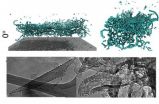(Press-News.org) Leading immunologists expect to see some clear advances in the fight against tuberculosis, an infectious disease that is widespread the world over. Professor Stefan Kaufmann, Director at the Max Planck Institute for Infection Biology in Berlin, echoed these sentiments at today's launch of the scientific programme for the 64th Lindau Nobel Laureate Meeting at Lindau, Germany. "In the past ten years, numerous attempts have been made to develop an improved vaccine. We are now justified in hoping that our vaccine will be effective," explained Professor Kaufmann. The vaccine developed by Kaufmann's research group is already undergoing Phase IIa clinical trials, during which its effectiveness and tolerability will be tested by trial participants. One-third of the world's population is infected with the tuberculosis pathogen Mycobacterium tuberculosis, and the disease claims 1.3 million lives each year.
Kaufmann attributes advances such as this in the fight against infectious diseases to the greater depth of knowledge acquired in recent decades about the body's own immune system defences. No fewer than three Nobel laureates who have played a major part in these discoveries are currently participating in the Lindau Nobel Laureate Meeting, which opened on Sunday. Jules Hoffmann from France, Bruce Beutler of the USA and Rolf Zinkernagel of Switzerland will be delivering presentations on the challenges facing modern immunology, one of the main emphases of the week-long programme. Between now and Friday, a total of 37 Nobel laureates will be engaged in an exchange of ideas with aspiring young scientists: over 600 selected undergraduates, doctoral students and post-docs from 80 countries, with the focus on physiology and medicine.
Stefan Kaufmann, Founding Director of the Max Planck Institute for Infection Biology and Professor of Microbiology and Immunology at the Charité in Berlin, is one of the two scientific chairpersons of the meeting and played a major role in defining the programme. He has a clear perspective on the direction in which his research area will continue to develop: "Over the next few years we must come to understand the immune system in the context of systems biology." One of the keys to this understanding lies in identifying the molecular and functional diversity of immunocompetent cells. Another lies in investigating the
complex interactions with the body's own, as well as foreign cells and substances. This knowledge will provide us with new approaches to the prevention and treatment of infectious diseases such as tuberculosis, and help to improve our understanding of allergies, autoimmune diseases and the body's own cancer surveillance mechanism.
The complexity of the biological and biochemical foundations that underlie the human immune system is one reason why tuberculosis, which has existed for thousands of years, is still being combated with a vaccine that is itself almost a hundred years old, and has proven to be of little effect; and why a six-month course of antibiotics is required to treat infected patients. The pathogen Mycobacterium tuberculosis skilfully evades the weapons available to the body, as well as to medicine. "The pathogen establishes itself in macrophages and obstructs an efficient immune response," Stefan Kaufmann explains. Inside these phagocytes, which actually support the body's immune system defences, the bacteria can remain inactive and survive for long periods of time, and so escape the majority of antibiotics. The thick, impermeable fat layer in the cell wall also provides protection for the pathogen.
"The old BCG vaccine against tuberculosis primarily activates only helper cells. The trick with our new vaccine is to additionally activate the killer cells, which enables us to trigger an improved immune system response," Kaufmann continues. In addition to research into vaccines, innovative treatments are also being investigated which attempt to entice the bacteria out of their macrophage hiding places.
INFORMATION:
The 64th Lindau Nobel Laureate Meeting ends on Friday, 4 July. It is organised by the Council for the Lindau Nobel Laureate Meetings and the Foundation Lindau Nobel Laureate Meetings.
Photos:
http://www.flickr.com/photos/nobellaureatemeeting
Media Information:
http://www.lindau-nobel.org → „Communications"
Videos:
http://www.mediatheque.lindau-nobel.org/meetings/2014
Blog:
http://www.blog.lindau-nobel.org
Progress in the fight against tuberculosis
2014-06-30
ELSE PRESS RELEASES FROM THIS DATE:
Artificial enzyme mimics the natural detoxification mechanism in liver cells
2014-06-30
Scientists at Johannes Gutenberg University Mainz in Germany have discovered that molybdenum trioxide nanoparticles oxidize sulfite to sulfate in liver cells in analogy to the enzyme sulfite oxidase. The functionalized Molybdenum trioxide nanoparticles can cross the cellular membrane and accumulate at the mitochondria, where they can recover the activity of sulfite oxidase.
Sulfite oxidase is a molybdenum containing enzyme located in the mitochondria of liver and kidney cells, which catalyzes the oxidation of sulfite to sulfate during the protein and lipid metabolism ...
The chemistry of fireworks: Fourth of July science (video)
2014-06-30
WASHINGTON, June 30, 2014 — The Fourth of July is just days away, and that means millions of Americans will soon enjoy eye-popping fireworks displays around the country. These dazzling light shows are actually carefully crafted chemical reactions. This week's Reactions episode features John Conkling, Ph.D., the professor who literally wrote the book on pyrotechnics. In the video, Conkling explains the chemistry that creates those amazing fireworks displays. The video is available at http://www.youtube.com/watch?v=nPHegSulI_M.
Subscribe to the series at Reactions YouTube, ...
Study finds low hand hygiene compliance rates during anesthesia administration
2014-06-30
Washington, DC, June 30, 2014 – Anesthesia providers are missing opportunities to clean their hands during surgical procedures, according to a study published in the July issue of the American Journal of Infection Control, the official publication of the Association for Professionals in Infection Control and Epidemiology (APIC).
In the study, researchers at Dartmouth-Hitchcock Medical Center used video observation to map patterns of anesthesia provider hand contact with anesthesia work environment surfaces to assess hand hygiene compliance. Researchers observed an average ...
Forelimb bone data predicts predator style
2014-06-30
At the start of their research, paleobiologists Christine Janis and Borja Figueirido simply wanted to determine the hunting style of an extinct marsupial called Thylacine (also known as the "marsupial wolf" or the "Tasmanian tiger"). In the end, the Australian relic, which has a very dog-like head but with both cat- and dog-like features in the skeleton, proved to be uniquely unspecialized, but what emerged from the effort is a new classification system that can capably predict the hunting behaviors of mammals from measurements of just a few forelimb bones.
"We realized ...
A key component of cell division comes to light
2014-06-30
VIDEO:
This is a video of the study about the dynamics of microtubule minus ends in the human mitotic spindle.
Click here for more information.
The division of a cell in two requires the assembly of the mitotic spindle, an extremely complex structure, which is the result of the coordinated action of a multitude of proteins and a finely tuned balance of their activities. A large part of the time that a cell requires to divide is devoted to assembling the mitotic spindle, which, ...
Study: Four Habits Model prepares pediatric nurses for emotionally difficult discussions
2014-06-30
INDIANAPOLIS -- A child's illness and hospitalization are extremely stressful for both the child and the parents. A new study reports that the Four Habits Model of Highly Effective Clinicians, a core set of communication skills developed to help physicians communicate with patients, can successfully prepare inexperienced nurses for emotionally difficult conversations with parents of pediatric patients.
The evidence-based Four Habits Model was co-developed 20 years ago by Regenstrief Institute investigator Richard Frankel, Ph.D., a sociologist and medical educator whose ...
Potential drug target for PTSD prevention
2014-06-30
Scientists at Yerkes National Primate Research Center, Emory University have identified a drug that appears to make memories of fearsome events less durable in mice.
The finding may accelerate the development of treatments for preventing PTSD (post-traumatic stress disorder). The drug, called osanetant, targets a distinct group of brain cells in a region of the brain that controls the formation and consolidation of fear memories.
The results were published in the journal Neuron.
"Potentially, drugs that act on this group of cells could be used to block fear memory ...
Green planning needed to maintain city buildings
2014-06-30
Green spaces in towns and cities need extra consideration as they may be damaging buildings in the area, according to new research from the Universities of Southampton and Surrey.
When organic chemicals from trees and vegetation mix with air pollutants the resulting corrosive gas can increase the erosion of building materials, including stone, concrete and steel.
Southampton's Dr Abhishek Tiwary, who is based within the Centre for Environmental Sciences, and Dr Prashant Kumar, from the University of Surrey, found that heritage buildings, built from limestone and sandstone, ...
Interlayer distance in graphite oxide gradually changes when water is added
2014-06-30
Physicists from Umeå University and Humboldt University in Berlin have solved a mystery that has puzzled scientists for half a century. They show with the help of powerful microscopes that the distance between graphite oxide layers gradually increases when water molecules are added. That is because the surface of graphite oxide is not flat, but varies in thickness with "hills" and "valleys" of nanosize. The new findings are published in the scientific journal Nano Letters.
"Now we can better understand the mechanisms of solvent insertion between layers of graphene oxide. ...
Researchers unzip nanotubes by shooting them at 15,000 mph
2014-06-30
Carbon nanotubes "unzipped" into graphene nanoribbons by a chemical process invented at Rice University are finding use in all kinds of projects, but Rice scientists have now found a chemical-free way to unzip them.
The Rice lab of materials scientist Pulickel Ajayan discovered that nanotubes that hit a target end first turn into mostly ragged clumps of atoms. But nanotubes that happen to broadside the target unzip into handy ribbons that can be used in composite materials for strength and applications that take advantage of their desirable electrical properties.
The ...




